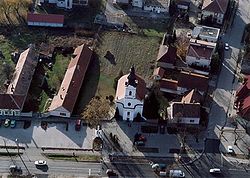Soltvadkert
Soltvadkert | |
|---|---|
 Aerial view | |
|
UTC+2 (CEST) | |
| Postal code | 6230 |
| Area code | +36 78 |
| Website | https://soltvadkert.hu/ |
Soltvadkert (
History
The town has been called Soltvadkert since 1900. Before that, it was called Vadkert, which is a reference to the region's active wildlife in
Lake Vadkert (also called Büdös-tó), is nearby Soltvadkert. It attracts many tourists every year from all over Europe.
Soltvadkert is well known throughout Europe for its wine production which goes back centuries in history. Its multicultural past, present, and future mainly depends on the grape and wine industry.
According to the 1910 census,[4] Soltvadkert had 7,836 residents. The religious make-up of the town was as follows:[5]
- Roman Catholic: 3,176 people (41%)
- Lutheran: 2,983 people (38%)
- Calvinist: 1,220 people (16%)
- Jewish: 312 people (4%)
- Other denomination: 145 people (2%)
Jewish history
Soltvadkert was home to a thriving
Rav Yehuda ("Reb Yiddel") Weber (1920–2006) was born in Soltvadkert to Rav Yisoscher (Berman) Weber, a descendant of the
By 1935, antisemitism was present in Soltvadkert. According to Jozsef Faludi, a student at the Soltvadkert yeshiva, there were often fights. The Christian children waited for Jewish students after lessons and threw rocks at them.
After the war, Soltvadkert became home to the last active yeshiva in Hungary under Rabbi Simon Yechezkel Jakobovics's (1902–1983) leadership with about 50 students. Among the students was Rav Yitzchak Schlesinger (died 2001), who became an advocate for the preservation of Jewish cemeteries in Hungary with a blessing from the
Geography and environment
Soltvadkert is located at 46°34'41" North, 19°23'45" East.[18] The village of Selymes located south of the town towards Kiskunhalas is administratively part of Soltvadkert.
Demographics
As the census of 2001 the people of Soltvadkert identified themselves as:
- Hungarian- 98.0%
- Romani - 0.7%
- Mixed/Other - 1.3%
Economy
Soltvadkert is the center of one of the biggest
Education
Soltvadkert is home to the Lajos Kossuth Elementary and Middle School (in Hungarian: Kossuth Lajos Általános és Művészeti Alapiskola), but does not have any
Religion
Soltvadkert is among the rare Hungarian towns that have a
The
In 1722, seven
The
The history of the
Government
The city of Soltvadkert is managed by the
- Temerini Ferencz, Mayor of Soltvadkert, FIDESZ 2,063 votes (67.84%)
- Galántai Norbert, FIDESZ,
- Kárász András, FIDESZ,
- Lantosné Dr. Mayer Zsuzsanna, FIDESZ,
- Medgyes Attila Jenő, independent representative
- Dr. Pozsgai Boglárka, FIDESZ
- Weppert Sándor, independent representative
- Zsikla Győző, independent representative
- Zsikla Tamás, FIDESZ
Tourism
Soltvadkert is one of Hungary's most visited towns. The city center has numerous specialty shops and
Sports
Vadkert FC is a professional
Twin towns
See also
References
- ^ Soltvadkert at the Hungarian Central Statistical Office (Hungarian).
- ^ Soltvadkert at the Hungarian Central Statistical Office (Hungarian). 2008
- ^ "Folia onomastica croatica 14/2005" (in Croatian). (462 KB) Živko Mandić: Hrvatska imena naseljenih mjesta u Madžarskoj,
- ^ "1910. ÉVI NÉPSZÁMLÁLÁS 1. A népesség főbb adatai községek és népesebb puszták, telepek szerint (1912) | Könyvtár | Hungaricana".
- ^ "1910. ÉVI NÉPSZÁMLÁLÁS 1. A népesség főbb adatai községek és népesebb puszták, telepek szerint (1912) | Könyvtár | Hungaricana".
- ^ "Jozsef Faludi".
- ^ "Laszlone Bernath".
- ^ "Letter by Rabbi Yeshaya Pollack, Rabbi of Soltvadkert | kedem Auction House Ltd".
- ^ "Bidspirit - Portail de ventes aux enchères en ligne Israélien | participation gratuite".
- ^ "Brooklyn, NY – Pupa Rebbetzin Passes Away At 101". vinnews.com. 2019-04-22.
- ^ "Lights of our righteous Tzaddikim" (PDF). panel.sendmsg.co.il.
- ^ "Chinuch.org::Gedolim Yahrtzeits". www.chinuch.org.
- ^ "Jozsef Faludi".
- ^ "Proclamation about the Ghettoization in Kiskőrös - "Assigning the Residences of the Jews" · EHRI Documents".
- ^ "Laszlone Bernath".
- ^ "Who Speaks For The Jews?" (PDF).
- ^ "Egy elveszett rabbigeneráció nyomában – Óbudai Zsinagóga honlapja".
- ^ "US Gazetteer files: 2010, 2000, and 1990". United States Census Bureau. 2011-02-12. Retrieved 2011-04-23.
External links
- Official website in Hungarian
- 2006 election results in Hungarian
- Vadkertinfo Local News in Hungarian


